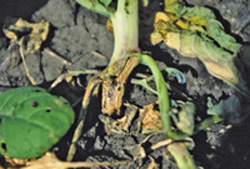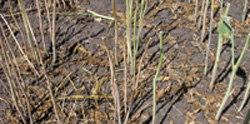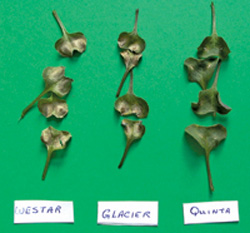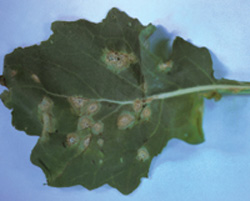
Features
Agronomy
Other Crops
Continuing the battle against blackleg strains
Researchers are seeking out novel ways to fight back against new strains of one of canola's most serious diseases.
November 29, 2007 By Carolyn King
Fighting against Leptosphaeria maculans, the pathogen that causes blackleg
disease in canola, is a seesaw of attacks and counterattacks. Over the years,
breeders have developed many canola varieties that are resistant to the pathogen's
most common strain on the prairies. So now the pathogen is bringing in fresh
reinforcements – other strains with greater potential to cause the disease.
 |
| Blackleg stem lesion on canola. Photo Courtesy Of R. Kutcher, AAFC. |
"I think the biggest challenge in blackleg research is that we are working
with a pathogen that is so capable of changing itself. If we think we are smart,
the pathogen is smarter!" says Dr. Dilantha Fernando, a plant scientist
at the University of Manitoba.
Researchers are now working on a range of strategies to fight back. These strategies
include developing better ways to identify blackleg strains and creating innovative
control options.
Sorting out the strains
Just getting a good handle on what strains we have on the prairies is more complex
than you might think.
About 15 years ago, before DNA techniques were developed to differentiate between
pathogen strains, researchers created a simple system for grouping blackleg
strains. This system assigns an isolate of the disease to one of five pathogenicity
groups (PGs) based on whether or not the isolate is able to infect one or more
of three canola cultivars, Westar, Quinta and Glacier (see Table 1).
"At that time, western Canada had mostly PG2s, while the variability of
the pathogen was greater in other parts of North American, Australia and Europe,
which had some or all of the other strains (PG2s, PG3s, PGTs and PG4s),"
says Dr. Randy Kutcher, a research scientist with Agriculture and Agri-Food
Canada (AAFC). PG1 does not cause virulent blackleg and is now considered to
be a separate, closely related species called Leptosphaeria biglobosa.
| Table 1. Pathogenicity grouping system for blackleg strains. | |||
| Pathogenicity group | Canola cultivar | ||
| Westar | Glacier | Quinta | |
| PG1 | No infection | No infection | No infection |
| PG2 | Infection | No infection | No infection |
| PG3 | Infection | Infection | No infection |
| PGT | Infection | No infection | Infection |
| PG4 | Infection | Infection | Infection |
Then things started to get more complicated. Kutcher and other AAFC researchers
conducted a survey of strains collected in Manitoba, Saskatchewan and Alberta
between 1998 and 2000. He says, "At that time, most of the isolates were
PG2s, but about 13 percent were PGTs, and we found a single PG3 isolate."
Since then, scientists including Fernando and others have been finding PG3,
PGT and PG4 on the prairies. Fernando's research group at the University of
Manitoba recently completed a study of blackleg samples received from farmers
and seed companies. He says, "From our prevalence studies, PG2 still predominates.
PG3, PGT and PG4 have not yet taken over, which may eventually happen."
Although such studies provide an idea of what strains we have, an extensive
prairie-wide survey would be needed to assess the impact that each pathogenicity
group is having on canola crops. Fernando explains that, although the provincial
governments do extensive disease surveys every year and report on blackleg's
occurrence and severity, they do not determine which strains are involved.
 |
| Canola cultivars resistant to PG2 strains but infected by PG3 strains. Photo Courtesy Of D. Fernando, University Of Manitoba. |
Perhaps one factor that may have discouraged an extensive survey of blackleg
strains is that the traditional method to identify the strains is a laborious
process taking about two months. Fernando's research group is now working on
a better method. This new method takes only about a week to 10 days, and it
is more accurate because it very clearly distinguishes between the DNA of the
different strains.
A further complexity in sorting out what strains exist is that the pathogen
is actually more diverse than the PG system can show, explains Kutcher. Westar
is not resistant to any blackleg strain, so the PG system actually relies on
just Quinta and Glacier to distinguish between the groups. Recent research shows
that Glacier has two genes for resistance, and Quinta has at least one and possibly
two. But researchers in France and other countries have identified at least
10 genes for resistance in canola and other Brassica species.
"That is telling us that the pathogenicity group system really isn't adequate,"
Kutcher says. "It is possible that variation in the blackleg population
of western Canada is greater than that identified by the PG system. We need
to describe the pathogenic variation of L. maculans in terms of the genes for
resistance in the host (Brassica species) and avirulence genes in the pathogen
(the genes in the pathogen which correspond to resistance genes in the cultivar)."
Kutcher is now working on this aspect. "In April of 2006 we began a study,
with support from the Saskatchewan Canola Development Commission and the Alberta
Canola Producers Commission through the Canola Council of Canada and the Matching
Investment Initiative of Agriculture and Agri-Food Canada, to characterize isolates
of L. maculans for avirulence genes in collections that exist at present.
A second objective is to characterize a number of past and present canola cultivars
for resistance genes."
He has brought a large number of prairie blackleg isolates to France, including
quite a few from Saskatchewan and some from Manitoba and Alberta. He says, "It's
not an exhaustive survey, but it will give us a good idea of what strains we've
got." He will be testing each isolate on 10 canola cultivars in the French
collection, each cultivar having a different gene for resistance, in order to
see which isolates cause blackleg on which cultivars.
 |
| Identifying PG3 blackleg strains. Photo Courtesy Of R. Kutcher, AAFC. |
Looking for new control options
Because blackleg is such an important disease of canola, researchers from many
public and private agencies are seeking out ways to fight these new strains.
For example, AAFC researchers are working on all aspects of the disease including
agronomic strategies, resistance strategies, breeding, and mapping and cloning
resistance genes. And Fernando's research group is working on a wide variety
of projects to find ways to control blackleg strains.
Fernando's group recently completed the first step in an interesting approach
to developing canola varieties with resistance to PG2, PG3 and PG4 strains.
"We have used PG1 (the non-virulent form) to inoculate plants so the plants
will be triggered to produce plant defense enzymes." It is almost like
giving the plant a vaccine so when the virulent blackleg pathogen comes along,
the plant is ready to defend itself. The next step in this long-term effort
will be to identify the main defence enzyme being produced by the PG1 inoculation.
Then the researchers will isolate the specific genes responsible for producing
that enzyme and incorporate those genes into the canola plant. Fernando says,
"That means the variety will always be producing that enzyme to be able
to withstand the pathogen when it attacks."
Fernando's group is also using molecular techniques to identify resistance
genes. The aim is to transfer genes for resistance against the other PGs into
a PG2-resistant cultivar to enable it to withstand attack from all PGs and increase
the durability of resistance.
Since the breakdown of resistance in new cultivars is related to changes in
the pathogen population in terms of avirulence genes, another project involves
analyzing blackleg samples from prairie fields each year to look for changes
in those genes.
His group is also developing an innovative biological control method for blackleg.
The researchers are using naturally occurring bacteria, isolated from the canola
plant or the soil, to fight the pathogen. The bacteria produce antibiotics that
suppress the germination of blackleg spores. So far, several novel compounds
have been isolated and tested against PG2 strains. The researchers are also
working towards cloning and characterization of the genes in the bacteria that
are responsible for producing the antibiotics. That would help in further genetic
manipulations such as development of transgenic plants capable of producing
the antifungal compound when attacked by the pathogen.
 |
| Canola leaf infected with blackleg. Photo Courtesy Of R. Kutcher, AAFC. |
Stick to your guns
Some of our current canola cultivars may have resistance to the new blackleg
strains. If the cultivars have been developed in areas where the new strains
occur and the cultivars are maintaining a high blackleg resistance rating, then
they are able to fight the new strains.
"For now, growers should continue the good practices they are used to
using: maintaining a good crop rotation, which is four years; using cultivars
with a high level of resistance to blackleg; and using good quality, treated
seed," says Kutcher.
He emphasizes the importance of continuing to use a variety of disease control
strategies. "For example, even if we have really good resistant varieties,
if we shorten our crop rotations, we're putting more and more pressure on the
fungus to overcome the resistance we're using. So we should always maintain
all the other methods of disease control to make resistance last."